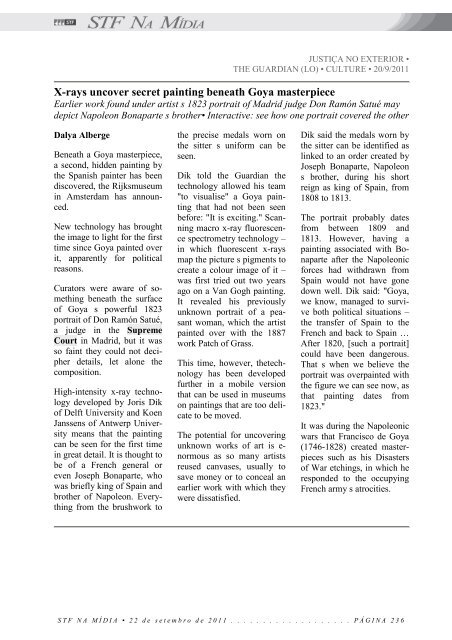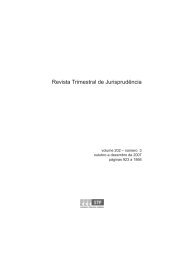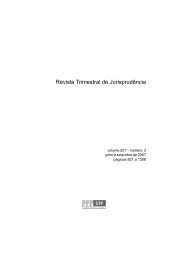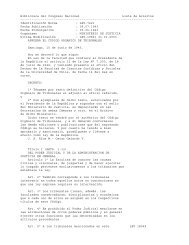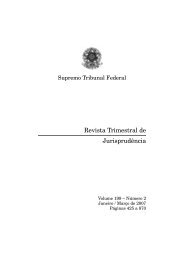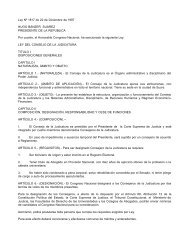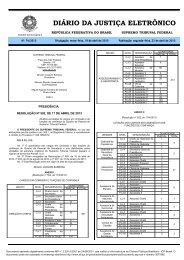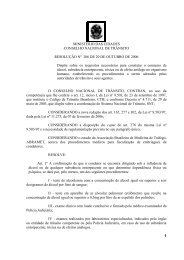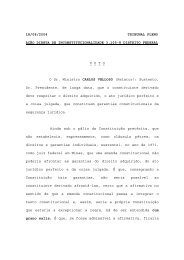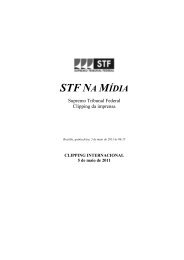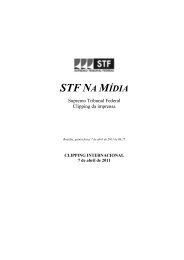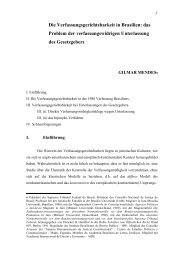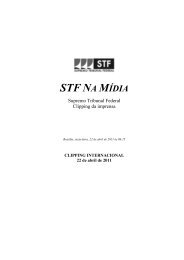STF NA MÍDIA
STF NA MÍDIA
STF NA MÍDIA
You also want an ePaper? Increase the reach of your titles
YUMPU automatically turns print PDFs into web optimized ePapers that Google loves.
JUSTIÇA NO EXTERIOR •<br />
THE GUARDIAN (LO) • CULTURE • 20/9/2011<br />
X-rays uncover secret painting beneath Goya masterpiece<br />
Earlier work found under artist s 1823 portrait of Madrid judge Don Ramón Satué may<br />
depict Napoleon Bonaparte s brother• Interactive: see how one portrait covered the other<br />
Dalya Alberge<br />
Beneath a Goya masterpiece,<br />
a second, hidden painting by<br />
the Spanish painter has been<br />
discovered, the Rijksmuseum<br />
in Amsterdam has announced.<br />
New technology has brought<br />
the image to light for the first<br />
time since Goya painted over<br />
it, apparently for political<br />
reasons.<br />
Curators were aware of something<br />
beneath the surface<br />
of Goya s powerful 1823<br />
portrait of Don Ramón Satué,<br />
a judge in the Supreme<br />
Court in Madrid, but it was<br />
so faint they could not decipher<br />
details, let alone the<br />
composition.<br />
High-intensity x-ray technology<br />
developed by Joris Dik<br />
of Delft University and Koen<br />
Janssens of Antwerp University<br />
means that the painting<br />
can be seen for the first time<br />
in great detail. It is thought to<br />
be of a French general or<br />
even Joseph Bonaparte, who<br />
was briefly king of Spain and<br />
brother of Napoleon. Everything<br />
from the brushwork to<br />
the precise medals worn on<br />
the sitter s uniform can be<br />
seen.<br />
Dik told the Guardian the<br />
technology allowed his team<br />
"to visualise" a Goya painting<br />
that had not been seen<br />
before: "It is exciting." Scanning<br />
macro x-ray fluorescence<br />
spectrometry technology –<br />
in which fluorescent x-rays<br />
map the picture s pigments to<br />
create a colour image of it –<br />
was first tried out two years<br />
ago on a Van Gogh painting.<br />
It revealed his previously<br />
unknown portrait of a peasant<br />
woman, which the artist<br />
painted over with the 1887<br />
work Patch of Grass.<br />
This time, however, thetechnology<br />
has been developed<br />
further in a mobile version<br />
that can be used in museums<br />
on paintings that are too delicate<br />
to be moved.<br />
The potential for uncovering<br />
unknown works of art is e-<br />
normous as so many artists<br />
reused canvases, usually to<br />
save money or to conceal an<br />
earlier work with which they<br />
were dissatisfied.<br />
Dik said the medals worn by<br />
the sitter can be identified as<br />
linked to an order created by<br />
Joseph Bonaparte, Napoleon<br />
s brother, during his short<br />
reign as king of Spain, from<br />
1808 to 1813.<br />
The portrait probably dates<br />
from between 1809 and<br />
1813. However, having a<br />
painting associated with Bonaparte<br />
after the Napoleonic<br />
forces had withdrawn from<br />
Spain would not have gone<br />
down well. Dik said: "Goya,<br />
we know, managed to survive<br />
both political situations –<br />
the transfer of Spain to the<br />
French and back to Spain …<br />
After 1820, [such a portrait]<br />
could have been dangerous.<br />
That s when we believe the<br />
portrait was overpainted with<br />
the figure we can see now, as<br />
that painting dates from<br />
1823."<br />
It was during the Napoleonic<br />
wars that Francisco de Goya<br />
(1746-1828) created masterpieces<br />
such as his Disasters<br />
of War etchings, in which he<br />
responded to the occupying<br />
French army s atrocities.<br />
S T F N A M Í D I A • 2 2 d e s e t e m b r o d e 2 0 1 1 . . . . . . . . . . . . . . . . . . . P Á G I N A 2 3 6


